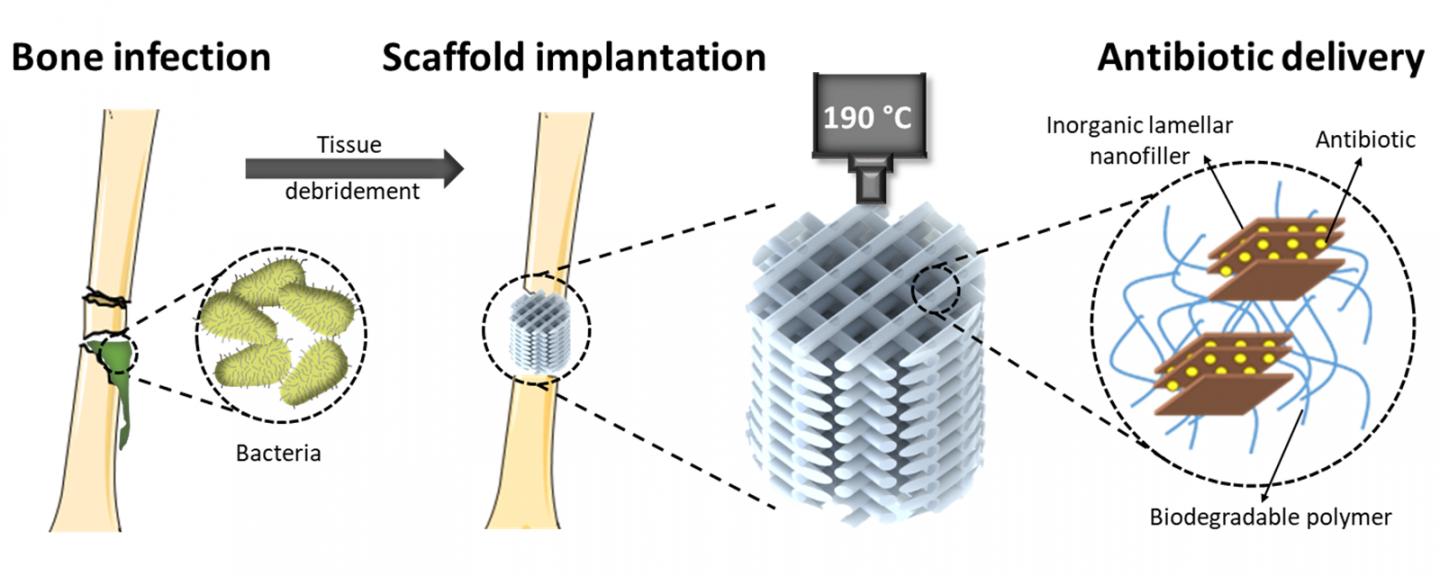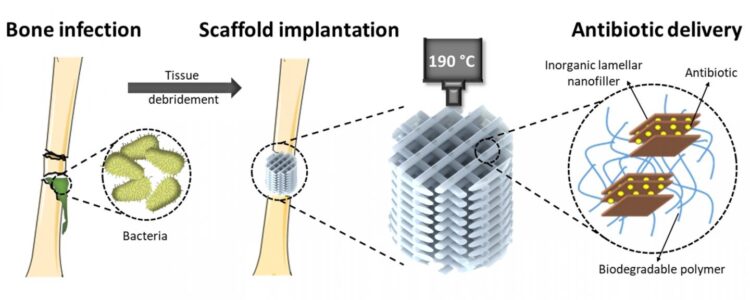
Credit: the Authors
In a ground-breaking first, researchers have fabricated 3D scaffold implants containing antibiotics at high temperatures. These scaffolds not only support bone regeneration but manage the bone infections that can arise as a result of injury or surgery.
Each year, around 4 million people worldwide develop bone infection following an open fracture or surgery. The gold standard treatment consists of a lengthy antibiotic therapy, usually delivered orally or Intravenously, and the removal of infected bone tissue, which often leaves behind a hole too large for the body to fill via normal bone regeneration. In a study published in the KeAi journal Bioactive Materials, a group of researchers from the Netherlands, Italy and Spain, outline a new treatment approach they have developed – novel antibiotic-releasing and biodegradable 3D printed scaffolds, capable of supporting bone regeneration and delivering antibiotics at the same time.
“Every person has their own individual body anatomy, which certainly requires a specific intervention in the event of bone injury,” explains one of the study’s authors, Lorenzo Moroni, professor in biofabrication for regenerative medicine at Maastricht University’s MERLN institute. “3D printed polymeric scaffolds possess several unique properties for bone regeneration: their shape can be tailored to fit the specific patient’s anatomy, they are porous to allow cell infiltration, but at the same time mechanically strong, and they can degrade over time to make space for the newly-formed bone. However, incorporating antibiotics in these scaffolds is not straightforward, since the 3D printing process consists of melting the material at high temperatures and antibiotics are heat sensitive.”
The study’s multidisciplinary team of scientists found that covering the antibiotics with lamellar inorganic protectors, prior to mixing them with the polymer and placing them in the 3D scaffolds, not only protected the antibacterial agents, it also enabled a more controlled release. This extended the period the antimicrobial were active and helped to keep local antibiotic concentrations under potentially toxic levels. At the same time, the cells in contact with these scaffolds maintained their viability and could perform normal cell functions, including bone formation – the ultimate goal of the implant.
According to Maria Camara-Torres, the investigator who led the study, this is a great breakthrough in the field of bone regeneration. “Until now, the direct incorporation of antibiotics and other bioactive molecules within 3D printed scaffolds has been limited to the few polymers that can be processed at low temperatures. Our novel approach shows that the library of polymers can be expanded to include many more.” She adds: “We hope that our results encourage scientists to continue investigating the use of lamellar inorganic fillers in combination with biomolecules to increase the functionality of 3D printed scaffolds in clinical applications.”
###
This research was part of the project FAST (Functionally graded Additive Manufacturing scaffolds by hybrid manufacturing), funded under the H2020-NMP-PILOTS-2015 scheme (GA n. 685825).
Contact the paper’s corresponding author: Lorenzo Moroni, [email protected]
Cámara-Torres, M., et al., 3D additive manufactured composite scaffolds with antibiotic-loaded lamellar fillers for bone infection prevention and tissue regeneration, Bioactive Materials, Volume 6, Issue 4, 2021, Pages 1073-1082,
https:/
The publisher KeAi was established by Elsevier and China Science Publishing & Media Ltd to unfold quality research globally. In 2013, our focus shifted to open access publishing. We now proudly publish more than 100 world-class, open access, English language journals, spanning all scientific disciplines. Many of these are titles we publish in partnership with prestigious societies and academic institutions, such as the National Natural Science Foundation of China (NSFC) .
Media Contact
Cassie He
[email protected]
Related Journal Article
http://dx.





